Ghodssi R., Lin P., MEMS Materials and Processes Handbook
Подождите немного. Документ загружается.

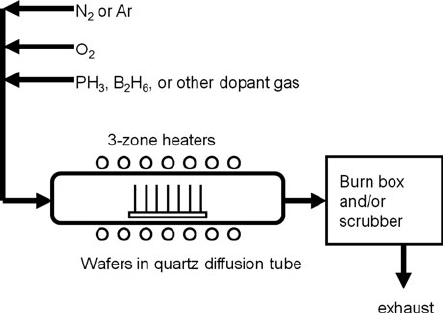
784 A.D. Raisanen
Fig. 10.23 Gas phase diffusion schematic. Process equipment is essentially a modified diffusion
furnace with provision for introducing dopant gases and dealing with toxic effluents
10.4.2 Solid State Diffusion
Sources of dopant atoms can be also conveniently introduced by applying a thin
film of material to the substrate to be doped. These thin films are often glass mate-
rials containing boron or phosphorus. Films of phosphorus- or boron-doped glass
can be applied with LPCVD deposition equipment using a low-pressure silane and
oxygen chemistry (at about 400
◦
C and 300 mtorr) with a small amount of added
PH
3
or B
2
H
6
. The dopant gas is often diluted in N
2
,orevenSiH
4
, to avoid hav-
ing to work with a 100% toxic gas cylinder under high pressure. Liquid dopants
such as Trimethylphosphite (P(OCH
3
)
3
and Trimethylborate (B(OCH
3
)
3
), available
from Air Products corporation of Allentown, PA, have become popular low-toxicity
substitutes for PH
3
or B
2
H
6
, respectively, and may be added to the SiO
2
deposition
process by entraining dopant vapor with N
2
or He in a bubbler. Typical doping levels
for boron- and phosphorus-doped glasses are 4–7 wt%, as higher levels of doping
are hygroscopic and can be difficult to work with.
Spin-on liquid materials are a very convenient doping method requiring little
process equipment and no toxic material storage [57]. These materials are available
for Sb, As, P, and B doping from Honeywell Electronic Materials in Tempe, AZ,
Emulsitone Corporation in Whippany, NJ, or Filmtronics Corporation in Butler, PA.
A typical process used in the author’s laboratory is illustrated i n Fig. 10.24, where
the liquid dopant is first spin-cast on a silicon wafer. Film thickness is generally not
critical. Excess solvent is driven off by a 15 min bake on a hotplate at 200
◦
C. The
coated wafers are loaded into a diffusion tube in a N
2
ambient and a diffusion pro-
cess is performed, with time and temperature selected to produce the desired doping
profile. Finally, the dopant glass is removed with a 10:1 solution of hydrofluoric
acid.

10 Doping Processes for MEMS 785
Fig. 10.24 Use of liquid
spin-on dopant materials
Solid-source dopant materials are another convenient source of dopant that does
not require toxic materials. Boron and phosphorus solid diffusion dopant sources
are available from Saint-Gobain Ceramics in Amherst, NY. Donor wafers made
of glass or silicon carbide saturated with boron or phosphorus-rich materials are
added to a furnace wafer carrier with the silicon wafers to be doped as shown in
Fig. 10.25. Silicon wafers are sandwiched between dopant source wafers and are
used in a slightly oxidizing ambient at atmospheric pressure. At the high temper-
atures utilized for diffusion, dopants diffuse out of the solid sources and immerse
the substrates in an ambient rich in dopant atoms, allowing indiffusion of dopant
into the target substrate. A thin coating of borosilicate or phosphosilicate glass is
left on the silicon surface after annealing which must be removed with hydrofluoric
acid. Dopant wafers are usable f or dozens of runs and are inert, nonflammable, and
nontoxic.
An old but extremely effective method of producing metallurgical junctions for
contacts and other heavily doped applications is the so-called alloy contact illus-
trated in Fig. 10.26, where an aluminum metal thin-film or small bead of material is
placed in contact with the semiconductor to be doped and contacted. Annealing the
contact above the Al–Si eutectic temperature at 577
◦
C allows some metal to diffuse
into the semiconductor, doping it p-type as indicated in Fig. 10.3. This forms a heav-
ily doped p-type region immediately below the metal, producing a diode in n-type
material (a), or an ohmic contact in p-type material (b). This technique also works
with indium metal, although it can be trickier due to the low melting point of indium.
Aluminum–antimony alloys can be used to form ohmic contacts to n-type material.
This technique was used early in the development of microelectronics to produce
diffused junctions for diodes and semiconductors, but was eventually replaced with
more controllable processes such as gas and solid-state diffusion [7].
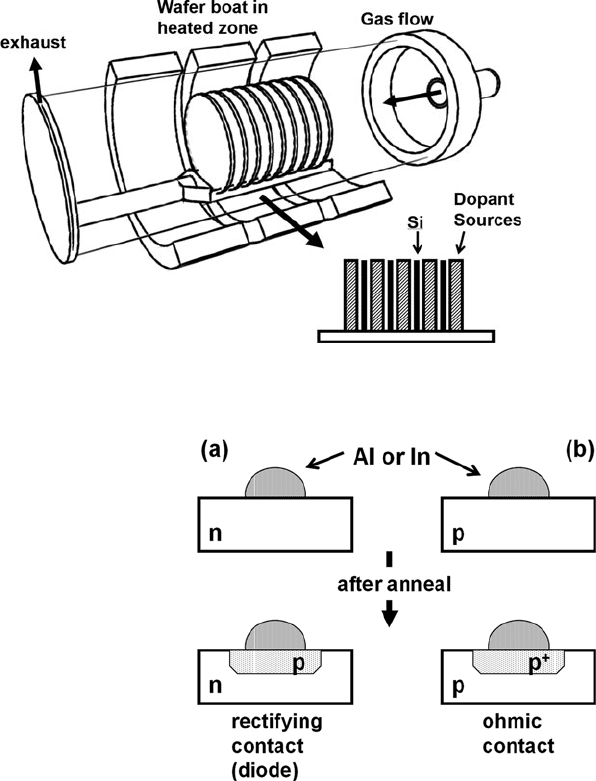
786 A.D. Raisanen
Fig. 10.25 Use of solid-source dopant wafers in diffusion tube
Fig. 10.26 Formation of
metallurgical junctions for
self-doped contacts. Al or In
metal balls sintered on the
surface of n-type silicon
produce diodes, and on p-type
silicon produce ohmic
contacts
10.4.3 Masking Materials
Doping blanket films or the entire surface of silicon wafers is straightforward, but
many devices require dopants to be placed in a specific area. This process requires
a mask material that can withstand the high temperatures encountered during the
diffusion process, which can run as high as 1250
◦
C for a deep diffusion in a SiC
furnace tube. The mask must also have a low diffusion coefficient for the dopant
that is being introduced. In practice SiO
2
and Si
3
N
4
films meet these requirements
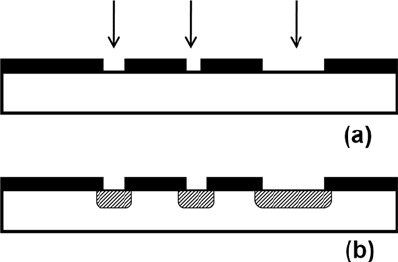
10 Doping Processes for MEMS 787
[58], and are generally convenient to deposit in any laboratory performing silicon
processing. Silicon nitride can be deposited with dichlorosilane and ammonia in a
LPCVD furnace [51]. To make certain it adheres to the silicon wafer throughout
the diffusion temperature cycle, it is advisable to put a thin (250–400 Å) thermally
grown SiO
2
layer underneath. Openings in the nitride can be formed by standard
lithographic t echniques and plasma etching in CF
4
or SF
6
.SiO
2
masks can be grown
by thermal oxidation and subsequently patterned with HF or plasma etching, or they
can be grown in specific areas by the LOCOS (local oxidation of silicon) process
(which uses a nitride mask) [7, 59]. Nitride films of about 1500 Å thickness are
typical, and oxide films from 2500 Å– 1.25 μm are common. See Fig. 10.27.
Fig. 10.27 Masking during diffusion. The mask material must have a very low diffusivity for
the dopant species while being able to resist temperatures of 1100
◦
Cormore.SiO
2
and Si
3
N
4
are common mask materials. Openings in the mask in (a) allow dopant atoms to diffuse into the
silicon. Lateral diffusion under the mask results in diffused areas slightly larger than the openings
in the mask as shown in (b)
10.4.4 Modeling
A variety of software packages is available to accurately model diffusion of dopant
atoms in the solid state, many based upon the SUPREM series of simulation models
developed at Stanford University. Code for one- and two-dimensional simulation
is available from Stanford University directly [60] or incorporated into a variety of
commercial software packages such as ATHENA by Silvaco Corporation. Modeling
ultrashallow junctions for advanced CMOS devices requires the latest code to
account for dopant clustering, transient diffusion enhancement, and other effects
not incorporated in the simple Fick’s law (Equations (10.3)–( 10.5)). However, for
MEMS applications, detailed modeling of dopant tails, transient diffusion and other
second-order effects are often more than necessary, and simple one-dimensional
analytical expressions are usually adequate to model the process required for doping
a boron etch stop to produce a given silicon diaphragm thickness.
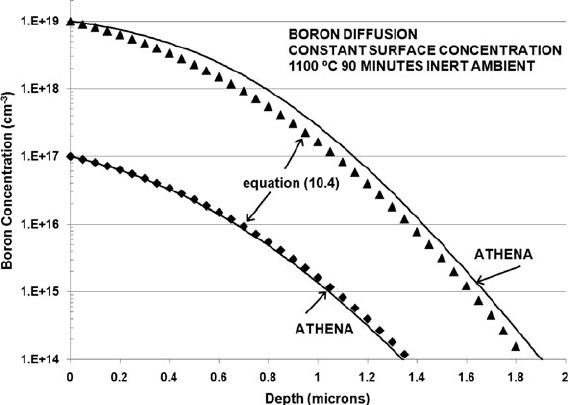
788 A.D. Raisanen
Fig. 10.28 Simulation of boron diffusion from a constant surface concentration of 1 ×10
17
cm
−3
and 1 ×10
19
cm
−3
at 1100
◦
C for 90 min. Solid lines are simulations using ATHENA, and discrete
markers are computed via Equation (10.4)
Figure 10.28 illustrates a comparison between an ATHENA simulation (solid
lines) and calculations from Equation (10.4) for a 90 min, 1100
◦
C boron diffusion
with constant surface dopant concentrations of 10
17
and 10
19
cm
−3
. Agreement is
quite good and only departs at the highest doping densities, where concentration
effects and electric fields induced by the high dopant concentration lead to higher
effective diffusivities. Even these factors can be substantially accounted for by using
diffusivities adjusted for concentration effects or ambient environments other than
inert gases (e.g., oxidizing environments during diffusion). See data tabulated in
Properties of Silicon (INSPEC, London, 1988). Brigham Young University at the
time of this writing has an excellent set of simple online diffusion and implant profile
calculation tools at their Electrical and Computer Engineering, which at the time of
this writing is hosted at http://cleanroom.byu.edu.
10.5 Ion Implantation
Ion implantation is a process for doping semiconductor substrates using ballis-
tic implantation of high-energy ions. It is more convenient than conventional
high-temperature diffusion processes as it allows simple control of dopant den-
sity by altering implant current and time, and good control of the dopant profile
by altering ion energy and thus implantation depth. A broader range of masking
materials is possible as well, inasmuch as the mask does not have to withstand a
high-temperature process, increasing convenience in patterning and mask removal.

10 Doping Processes for MEMS 789
Significant crystal damage occurs during the implantation process, which gener-
ally must be repaired by annealing processes to restore useful crystal structure and
activate the dopant atoms.
A high-energy ion affecting a solid will undergo a number of electronic and phys-
ical collisions until it comes to rest. In general, heavy ions, such as arsenic, do not
penetrate as far as light ions, such as boron. The interaction between incoming ions
and the silicon lattice is composed of two components, nuclear and electronic. The
nuclear interaction is essentially a physical collision between the incoming ion and
a l attice atom, and scales with the atomic weight of the ion. The nuclear interac-
tion also depends on energy, with a lower collision cross-section at high energies.
The electronic interaction is an interaction between the incoming charged ion and
the electronic structure of the solid. Motion of the ion through the solid produces
a realignment of electrons in the solid, gradually draining kinetic energy from the
ion as it passes. As the ion enters the solid, it loses energy from electronic interac-
tions, increasing the effective nuclear cross-section of the ion. A nuclear collision
will eventually occur, with the probability of that collision being maximized at some
depth below the surface at which the nuclear collision cross-section is maximized by
the electronic energy loss. Plots of the ion density deposited in a solid as a function
of penetration depth will have a characteristic peak depending on ion energy and
mass, with an approximately Gaussian profile around the peak position, as illus-
trated in Fig. 10.29 for 100 keV implants in silicon calculated using ATHENA and
a simple Gaussian model.
Fig. 10.29 Simulated dopant profile for ion-implanted boron, phosphorus, and arsenic at 100 keV
and 1 × 10
14
ions/cm
−3
. Lighter ions penetrate more deeply into the silicon. Calculated using
ATHENA

790 A.D. Raisanen
The depth of the Gaussian implant concentration peak and the width of the peak
(standard deviation), called the longitudinal straggle, is determined by the relative
electronic and nuclear scattering cross-sections for the ion and substrate atoms.
These cross-sections are tabulated for many i ons, and can be calculated to a high
degree of accuracy using software tools such as SRIM (stopping range of ions in
solids) [61]. SRIM calculations for ion range and longitudinal straggle are shown
in Fig. 10.30 for boron, phosphorus, and arsenic implants in silicon up to 300 keV.
These calculations may be used to estimate the position of the highest dopant con-
centration as well as the width of the implanted dopant distribution. The maximum
dopant contribution of the implanted distribution is related to the total implanted
doseby[59].
Q =
√
2πR
P
C
P
, (10.6)
where Q is total dose implanted (atoms/cm
2
), R
P
is the longitudinal straggle from
SRIM or Fig. 10.30, and C
P
is the peak concentration in atoms/cm
3
.
These simple calculations allow estimates to be made for the proper energy and
dose to provide a given implant profile, but more sophisticated calculations are
best conducted using a simulation tool such as SUPREM IV [60]orATHENA
(Silvaco Corp, Santa Clara, CA). In particular, activation of dopants will broaden
the implanted profile through diffusion, and ions implanted in a crystalline solid
undergo processes such as channeling, which are not accounted for by SRIM and
simple Gaussian profile calculations.
Unlike diffusion methods, which result in the highest dopant concentration at the
surface in contact with the dopant source, ion implant processes can easily place the
ion dose well below the substrate surface, enabling structures such as deep buried
channels. Ions can also be implanted through overlying structures at sufficiently
high energies. Ion implant offers unique process opportunities by decoupling dopant
concentration (ion current) and dopant profile (ion energy), which is not possible
with basic diffusion processes.
10.5.1 Equipment
Ion implantation is performed by a small particle accelerator that ionizes atoms
from a solid or gaseous dopant source. To produce a beam of dopants, a suitable
source material must first be vaporized and ionized. A simple ion source can be
constructed by using a hot filament to ionize a gaseous feedstock containing dopant
atoms. Historically, BF
3
gas is used to produce boron dopants, PH
3
is used for
phosphorus implants, and AsH
3
is used for arsenic implants. Because many of these
gas dopant materials are highly toxic, there is a trend toward safer delivery systems
than high-pressure gas bottles, such as the subatmospheric Safe Delivery Source
TM
systems pioneered by Advanced Technology Materials Corp. Solid materials can be
utilized as source materials by direct thermal sublimation or vaporization in a more
complex electric arc or inductively coupled plasma source.
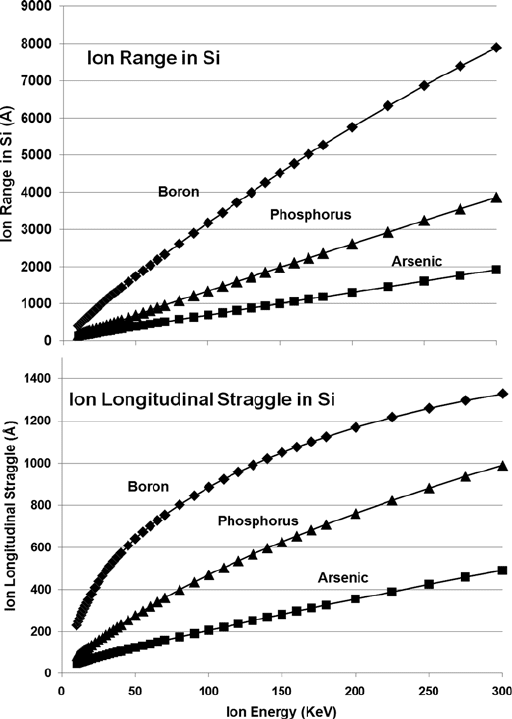
10 Doping Processes for MEMS 791
Fig. 10.30 Calculated ion range and longitudinal straggle, in angstroms, for boron, phosphorus,
and arsenic ions in silicon. Calculated using SRIM [61]
Once a stream of ions is produced from a source, a mass selector extracts the
desired dopant from the ionizer and accelerates the ions to the desired energy.
Mass selectors may be conventional magnetic sectors as illustrated in Fig. 10.31
or quadrupole mass filters. Focusing optics produce a collimated beam that can be
directed onto the substrates, and rastering electrostatic or magnetic optics scan the
beam across the wafer surface. In high-current machines, the substrates themselves
are mechanically scanned across the beam. At high beam currents an electron flood
source is utilized to neutralize the surface charge produced by the ion bombardment,
and a wafer cooling system may be used to prevent excessive temperature increase
of the wafers and subsequent damage to masking materials.
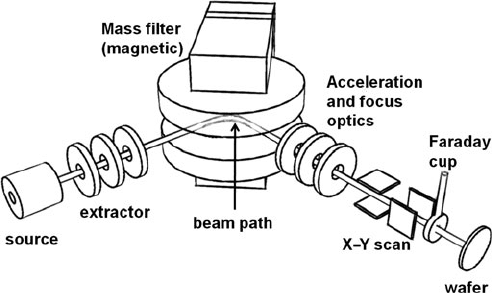
792 A.D. Raisanen
Fig. 10.31 Schematic of a medium-current ion implant system
Specialized implanters are available for specific tasks. Medium-current
implanters operate well from about 5–200 keV ion energy, with currents up to a
few milliamps. Individual substrates are typically held stationary, and the beam
is electronically rastered over the surface by an X−Y scanning system. Medium
current machines are good for producing moderate implant doses (up to about
(>1 × 10
14
− 5 × 10
16
ions/cm
2
) with high throughputs, suitable for such appli-
cations as channel stop and threshold adjust implants. Obviously, higher doses
are obtainable by simply using longer exposures and accepting lower process
throughput. High-current implanters are optimized for producing very large doses
(>1 ×10
14
−5 ×10
16
ions/cm
2
) for source/drain implants, polysilicon doping, and
SOI wafer production. Typically high-current implanters mount a batch of wafers
on a cooled rotating stage assembly. The ion beam is rastered in a linear or fan pat-
tern rather than in two dimensions, and the stage is rotated and translated through
the linear beam pattern to uniformly irradiate each wafer.
A third variation of the basic ion implanter technology is the low-energy
implanter, optimized for producing ion beams at low energies, <10 keV.
Conventional implanters have difficulty in obtaining high-current beams at the
low energies useful for producing very shallow dopant profiles, so low-energy
implanters have been developed with short beam paths and optics optimized for
low-energy, high-current ion beams.
10.5.2 Masking Materials
A wide variety of masking materials are usable with ion-implant processes. Silicon
dioxide, silicon nitride, polysilicon, and metals are sometimes used for implant
masks, especially in “self-aligned” processes that place implanted species in silicon
laterally adjacent to the edge of an overlying structure. Conventional photoresist
is probably the most commonly used material as it is easy to apply, pattern, and
10 Doping Processes for MEMS 793
remove after the implant is complete, in contrast to the hard masking materials
required for high-temperature diffusion processes. Resist damage or burning can
be an issue with high-current implants, and aggressive removal methods with oxy-
gen plasmas or sulfuric acid/peroxide stripping solutions are often required to strip
the damaged polymer. Candidate materials for masks, or even complete stacks of
dissimilar materials, can be easily simulated for ion stopping effectiveness using the
SRIM [61] simulation software.
10.5.3 Modeling
Simple calculations of implanted profiles may be performed using software tools
such as SRIM [61] or by estimating implant depths from tabulated cross-section
values [61, 62]. For relatively coarse applications, such as generation of a heav-
ily doped boron stop layer or production of a heavily doped polysilicon layer,
these estimates will often suffice. However, thermal cycles must be included after
implant as dopants will diffuse through the crystal during activation with conven-
tional thermal methods. This can be approximated by Gaussian broadening the
implanted profile via Equation (10.5), or by simply using a modeling tool such as
SUPREM.
For more precise work including perturbations such as ion channeling, amor-
phous layers, or implant through oxides or other surface films, a 1-D or 2-D process
simulator is indispensable. For example, Fig. 10.32 illustrates a high-dose boron
implant of 1 ×10
16
B11+ at 100 keV, before and after an anneal in an inert environ-
ment of 90 min at 1100
◦
C. As-implanted, the boron profile has a significant shoulder
at higher depths due to ions “channeling” through preferred directions in the crystal
structure [63]. One such channel is shown in Fig. 10.33 through a silicon–diamond
structure. At the correct angle, long “tunnels” extend through the crystal struc-
ture allowing ions to penetrate anomalously deep with little chance of scattering.
The presence of this shoulder is not predicted by range calculations in Fig. 10.30,
which would lead to predictions of the implanted profile being shallower and of
higher concentration than it actually is. The channeling effect can be suppressed
by implanting through a thin screening oxide and adding a small tilt to the sub-
strate to prevent ions from entering at the channeling angle. Simulation codes based
on SUPREM can simulate the channeling effect by using dual-Pearson implant
profiles [64].
10.5.4 Crystal Damage
Ion scattering from a solid through electronic interactions produce relatively lit-
tle damage to the crystal structure, but actual collisions between ion cores during
nuclear interactions can cause severe crystal damage. These collisions are essen-
tially elastic in nature, and sufficiently high-energy events can cause a cascade of
